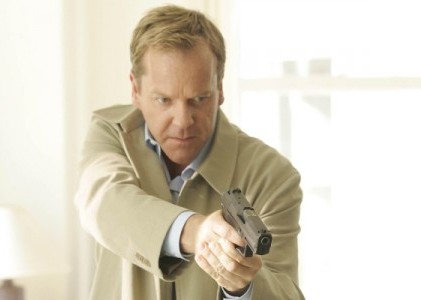5 on 24, Pt 1: Ticking Clock
The May 24 finale of the political-action series 24 marks the end of one of the most stylistically fresh and politically controversial programs in broadcast TV history. The video essay series 5 on 24 examines various aspects of the show, including its real-time structure, its depiction of torture, and the psychology of its hero, counterterrorist agent Jack Bauer. To view part 2, click here; part 3, click here; part 4, click here; and part 5, click here.
The following video essay takes place in real time.
If you're looking for a series to remind you what it felt like to be alive and American in the 2000s, 24 is the show to beat.
The Sopranos, Deadwood, The Shield, and other cable series were more acclaimed for their artistry—perhaps rightly so. But 24 was as conceptually bold as its peers, and it aired on a broadcast network—a venue in which job one was to thrill.
And with its combination of beat-the-clock plotting, R-rated violence, and straightforward engagement with the dominant political issues of the day, 24 changed our perceptions of what a dramatic series could do. And from New York Times think pieces to university courses, from Taken to the reboot of the James Bond franchise, its impact was wide and deep.
But before all this importance befell the series, it was just a show with a risky hook hoping to get a full-season pickup.
With rare exceptions, action series made prior to 24 were self-contained "adventures" that focused on stunt casting and/or cartoony and often weightless situations.
But starting in the 1990s, TV realized that Hollywood had all but given up trying to appeal to grownups, and filled the marketplace gap with the likes of ER, the Law and Order franchise, and the aforementioned cable dramas—accessible adult series that had a bit of an edge and that offered meaty parts for driven but unconventional actors.
24 was meant to be the action-adventure version of such shows, mixing topical content, graphic violence, and plotting so complex you needed a flow chart to follow it. Sutherland, an intense actor who had teetered on the brink of superstardom for 15 years without quite achieving it, proved the perfect actor for the series' pressure-cooker situations. And his voice set the tempo for the show.
The hook of having an entire season of a TV series take place in real time represented the fullest possible flowering of a certain school of action cinema. The real time structure of Nick of Time—a mostly unheralded ancestor of 24—contributed another layer of excitement to an already tense thriller. Watching it, you simultaneously wondered how the hero would escape the tight spot he was in and how the filmmakers would manage to keep the pedal to the metal without exhausting the audience.
The bomb-on-a-bus thriller Speed may have been the biggest overall influence on 24. It devised cliffhangers within both a set time limit and confined spaces. And it featured a hero who had superhuman determination but human feelings.
Action shows like Magnum P.I., Hunter, and MacGyver specialized in self-contained episodes that usually ended with a chase and/or explosion-disaster prevented and order restored. But the real-time, day-in-the-life structure of 24 was an extension of the limited-run format of British television, successfully adopted by such American shows as The Sopranos.
24 hooked this format up to an IV drip bag of pure adrenaline. The series was Speed crossed with a Tom Clancy novel and stretched out over 24 merciless weeks. Even the down time was nerve-racking. Each episode flowed into the next while still delivering the expected weekly cliffhanger, twist, or revelation.
The show tapped into the ticking-clock on-the-go mentality of post-millennial society. And its machine-gun pacing, real time structure, and long-form plotting took aesthetic risks that no other action show had dared.
In the summer before its scheduled fall 2001 premiere, 24 was the most talked-about new series on network TV and had already been hailed by critics as one of the riskiest stylistic experiments in TV history.
Come September, nobody cared about any of that. The cockiest country on earth had been shocked back to the primal terror of childhood. We wanted comfort. We wanted safety.
We wanted payback. ![]()
LATEST ARTICLES
-20140814-173707-thumb3.jpg)
Fighting Words
by Imogen Sara Smith
posted August 12, 2014

Fighting Words, Part 2
by Imogen Sara Smith
posted August 20, 2014

On the Margins: The Fil…
by Andrew Chan
posted August 12, 2014

Robin Williams: A Sense…
by David Schwartz
posted August 12, 2014
 5 on 24, Pt 1: Ticking Clock
5 on 24, Pt 1: Ticking Clock
 5 on 24, Part 1
5 on 24, Part 1
THE AUTHORS
San Antonio-based film critic Aaron Aradillas is a contributor to The House Next Door, the founder and publisher of Rockcritics.com and the host of “Back by Midnight,” an Internet radio program about film and television.
More articles by Aaron AradillasMatt Zoller Seitz is a writer and filmmaker whose debut feature, the romantic comedy Home, is available through Netflix and Amazon. His writing on film and television has appeared in The New York Times, New York Press, and The Star Ledger, among other places. He is also the founder of The House Next Door, a movie and TV criticism website.
More articles by Matt Zoller SeitzAuthor's Website: The House Next Door

